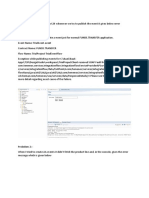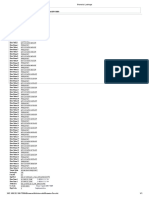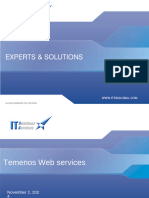OPC Overview: OPC (OLE For Process Control)
OPC Overview: OPC (OLE For Process Control)
Uploaded by
sifuszCopyright:
Available Formats
OPC Overview: OPC (OLE For Process Control)
OPC Overview: OPC (OLE For Process Control)
Uploaded by
sifuszOriginal Description:
Original Title
Copyright
Available Formats
Share this document
Did you find this document useful?
Is this content inappropriate?
Copyright:
Available Formats
OPC Overview: OPC (OLE For Process Control)
OPC Overview: OPC (OLE For Process Control)
Uploaded by
sifuszCopyright:
Available Formats
OPC Overview
OPC (OLE for Process Control) is a series of standards specifications. The first standard (originally called simply the OPC Specification and now called the Data Access Specification) resulted from the collaboration of a number of leading worldwide automation suppliers working in cooperation with Microsoft. Originally based on Microsoft's OLE COM (component object model) and DCOM (distributed component object model) technologies, the specification defined a standard set of objects, interfaces and methods for use in process control and manufacturing automation applications to facilitate interoperability. The COM/DCOM technologies provided the framework for software products to be developed. There are now hundreds of OPC Data Access servers and clients available.
Adding the OPC specification to Microsoft's OLE technology in Windows allowed standardization. Now the industrial devices' manufacturers could write the OPC DA Servers and the software (like Human Machine Interfaces HMI ) could become OPC Clients.
The benefit to the software suppliers was the ability to reduce their expenditures for connectivity and focus them on the core features of the software. For the users, the benefit was flexibility. They don't have to create and pay for a custom interface. OPC interface products are built once and reused many times, therefore, they undergo continuous quality control and improvement.
The user's project cycle is shorter using standardized software components. And their cost is lower. These benefits are real and tangible. Because the OPC standards are based in turn upon computer industry standards, technical reliability is assured.
The original specification standardized the acquisition of process data. It was quickly realized that communicating other types of data could benefit from standardization. Standards for Alarms & Events, Historical Data, and Batch data were launched.
Current and emerging OPC Specifications include:
| Specification Description The originals! Used to move real-time data from PLCs, DCSs, and other control OPC Data devices to HMIs and other display clients. The Data Access 3 specification is now a Access Release Candidate. It leverages earlier versions while improving the browsing capabilities and incorporating XML-DA Schema. Provides alarm and event notifications on demand (in contrast to the continuous data OPC Alarms flow of Data Access). These include process alarms, operator actions, informational & Events messages, and tracking/auditing messages. This specification carries the OPC philosophy to the specialized needs of batch OPC Batch processes. It provides interfaces for the exchange of equipment capabilities (corresponding to the S88.01 Physical Model) and current operating conditions. This specification takes us from client/server to server-to-server with communication OPC Data across Ethernet fieldbus networks. This provides multi-vendor interoperability! And eXchange adds remote configuration, diagnostic and monitoring/management services. Where OPC Data Access provides access to real-time, continually changing data, OPC OPC Historical Data Access provides access to data already stored. From a simple serial Historical data logging system to a complex SCADA system, historical archives can be retrieved Data Access in a uniform manner. All the OPC servers provide information that is valuable to the enterprise and if improperly updated, could have significant consequences to plant processes. OPC OPC Security specifies how to control client access to these servers in order to protect this Security sensitive information and to guard against unauthorized modification of process parameters. Provides flexible, consistent rules and formats for exposing plant floor data using XML, OPC XML-DA leveraging the work done by Microsoft and others on SOAP and Web Services. OPC A companion specification to Data Access and XML-DA that allows servers to expose Complex and describe more complicated data types such as binary structures and XML Data documents. A Working Group has been formed to develop a new set of interfaces that allow OPC OPC clients and servers to identify, send and monitor control commands which execute on Commands a device.
Distributed COM
The DCOM Architecture DCOM is an extension of the Component Object Model (COM). COM defines how components and their clients interact. This interaction is defined such that the client and the component can connect without the need of any intermediary system component. The client calls methods in the component without any overhead whatsoever.
Figure 1: COM components in the same process
In today's operating systems, processes are shielded from each other. A client that needs to communicate with a component in another process cannot call the component directly, but has to use some form of interprocess communication provided by the operating system. COM provides this communication in a completely transparent fashion: it intercepts calls from the client and forwards them to the component in another process.
Figure 2: COM components in different processes
When client and component reside on different machines, DCOM simply replaces the local interprocess communication with a network protocol. Neither the client nor the component is aware that the wire that connects them has just become a little longer. Figure 3 shows the overall DCOM architecture: The COM run-time provides object-oriented services to clients and components and uses RPC and the security provider to generate standard network packets that conform to the DCOM wire-protocol standard.
Figure 3: DCOM: COM components on different machines Components and Reuse Most distributed applications are not developed from scratch and in a vacuum. Existing hardware infrastructure, existing software, and existing components, as well as existing tools, need to be integrated and leveraged to reduce development and deployment time and cost. DCOM directly and transparently takes advantage of any existing investment in COM components and tools. A huge market for off-the-shelf components makes it possible to reduce development time by integrating standardized solutions into a custom application. Many developers are familiar with COM and can easily apply their knowledge to DCOM-based distributed applications.
You might also like
- Structured Products BuilderDocument26 pagesStructured Products BuilderHmani EmnaNo ratings yet
- SAP HANA Developer Guide For SAP HANA Studio enDocument782 pagesSAP HANA Developer Guide For SAP HANA Studio enJoseph KachereNo ratings yet
- Course "EEM 2 DC Machines": WWW - Lucas-Nuelle - deDocument17 pagesCourse "EEM 2 DC Machines": WWW - Lucas-Nuelle - desifuszNo ratings yet
- MQ Installation ProcessDocument1 pageMQ Installation Processj. koteswaraoNo ratings yet
- Title Block A4 PDFDocument1 pageTitle Block A4 PDFsifuszNo ratings yet
- Analysis DocumentDocument2 pagesAnalysis DocumentankurNo ratings yet
- TAPCore ScriptLanguage ReferenceGuideDocument231 pagesTAPCore ScriptLanguage ReferenceGuidekiatipisNo ratings yet
- Business Functions User GuideDocument69 pagesBusiness Functions User GuideMílìnd RàjwàrdhànNo ratings yet
- Triconex OPC UA Server User's GuideDocument30 pagesTriconex OPC UA Server User's Guideguillermo muñozNo ratings yet
- Temenos Solution Brief Final With XIODocument2 pagesTemenos Solution Brief Final With XIOazza younessNo ratings yet
- Jbase3 XProgrammersReferenceManualDocument699 pagesJbase3 XProgrammersReferenceManualPrashanth SrinivasanNo ratings yet
- TAPCore SystemManagement GuideDocument257 pagesTAPCore SystemManagement GuidekiatipisNo ratings yet
- Eb - Lookup S Ecmb - Loan.frequency - MeDocument1 pageEb - Lookup S Ecmb - Loan.frequency - MeCristhian MoralesNo ratings yet
- WebSphere ATMFRM Configuration TAFJDocument20 pagesWebSphere ATMFRM Configuration TAFJstylesofNo ratings yet
- DFE Rule EngineDocument14 pagesDFE Rule Enginethe.painkiller.leadNo ratings yet
- TAFC or JBASE ConfigDocument21 pagesTAFC or JBASE ConfigGopinath KannasamudramNo ratings yet
- R24AMR ReleaseHighlightsDocument425 pagesR24AMR ReleaseHighlightsnagarjunt24100% (1)
- Java Temenos Connector Server Plugin Isolistener - JarDocument5 pagesJava Temenos Connector Server Plugin Isolistener - JarBIDC EmailNo ratings yet
- R10 On XPDocument182 pagesR10 On XPadenihun Adegbite100% (1)
- FILE - 20220713 - 184426 - How Do I Generate CRB ReportsDocument12 pagesFILE - 20220713 - 184426 - How Do I Generate CRB ReportstienmhNo ratings yet
- Red Hat Enterprise Linux-6-Virtualization Tuning and Optimization GuideDocument37 pagesRed Hat Enterprise Linux-6-Virtualization Tuning and Optimization GuideRomário HornburgNo ratings yet
- Security User GuideDocument42 pagesSecurity User GuideAnonymous ZGcs7MwsLNo ratings yet
- CS2305 Programming ParadigrmDocument12 pagesCS2305 Programming ParadigrmAnonymous 8pCXXsNo ratings yet
- ADM4.PrinterSetupInjBASEAndT24 R10.01Document59 pagesADM4.PrinterSetupInjBASEAndT24 R10.01kripeshNo ratings yet
- Trace AbilityDocument11 pagesTrace AbilitySuhasini ANo ratings yet
- Units of The Product-R16Document19 pagesUnits of The Product-R162323No ratings yet
- TCIB8 Customisation R14Document31 pagesTCIB8 Customisation R14Mílìnd Ràjwàrdhàn100% (1)
- T24 Parameter TablesDocument58 pagesT24 Parameter TablesSaranya AnandNo ratings yet
- TAFC R10 SP54 Release NotesDocument10 pagesTAFC R10 SP54 Release NotesBejace NyachhyonNo ratings yet
- TAFJ DSPackageInstallerDocument39 pagesTAFJ DSPackageInstallerMrCHANTHANo ratings yet
- JE - Quick LearningDocument13 pagesJE - Quick LearningLakshmi PalanikumarNo ratings yet
- TAPCore OrdersProductivity GuideDocument224 pagesTAPCore OrdersProductivity Guidekiatipis100% (1)
- Continue: Temenos t24 User Guide PDFDocument3 pagesContinue: Temenos t24 User Guide PDFTanaka MachanaNo ratings yet
- Jbase SQLDocument29 pagesJbase SQLZakaria AlmamariNo ratings yet
- Architecture Overview 4Document26 pagesArchitecture Overview 4Mílìnd Ràjwàrdhàn100% (1)
- T24 Temenos WebServices - ITSSDocument59 pagesT24 Temenos WebServices - ITSSzhioua.mhammedNo ratings yet
- TAFJ DeprecationMechanimDocument11 pagesTAFJ DeprecationMechanimShaqif Hasan SajibNo ratings yet
- R10 Model Bank Installation Guide PDFDocument7 pagesR10 Model Bank Installation Guide PDFedNo ratings yet
- Info BasicDocument22 pagesInfo BasiclolitaferozNo ratings yet
- Global and Institutional ConstraintsDocument43 pagesGlobal and Institutional ConstraintsHmani EmnaNo ratings yet
- Image ManagementDocument23 pagesImage ManagementHmani EmnaNo ratings yet
- Customer Profitability Installation Guide R18.1Document33 pagesCustomer Profitability Installation Guide R18.1Abdelmadjid BouamamaNo ratings yet
- L3 Api Generation in R23 1Document6 pagesL3 Api Generation in R23 1Iniyanila GNo ratings yet
- Aa AccountDocument163 pagesAa AccountLe Duc AnhNo ratings yet
- 9.TAFJ TAFJ EE JBoss Eap 6x R17.01Document42 pages9.TAFJ TAFJ EE JBoss Eap 6x R17.01krishnaNo ratings yet
- CUS14-Version CustomisationDocument24 pagesCUS14-Version CustomisationViệt NguyễnNo ratings yet
- S.No. Descriptions Arrays: Only in Reasonable Cases (E.g. Too Many Casts Would Have Been Necessary)Document18 pagesS.No. Descriptions Arrays: Only in Reasonable Cases (E.g. Too Many Casts Would Have Been Necessary)Surinder SinghNo ratings yet
- TAFJ-IBM MQ With WEBLOGIC Using SSL ConnectivityDocument29 pagesTAFJ-IBM MQ With WEBLOGIC Using SSL ConnectivityT24LINK.COMNo ratings yet
- Account - Parameter: Posting RestrictionsDocument2 pagesAccount - Parameter: Posting RestrictionslolitaferozNo ratings yet
- T24-IT-Comments-Signed Off BRD For IBAN ProjectDocument32 pagesT24-IT-Comments-Signed Off BRD For IBAN Projectnobodyknows706No ratings yet
- FOREXDocument57 pagesFOREXRACHED Amira100% (1)
- Oracle TF Suite PDFDocument598 pagesOracle TF Suite PDFmais dawasNo ratings yet
- TAFJ-AS WebLogicInstallDocument66 pagesTAFJ-AS WebLogicInstallS.M. SayeedNo ratings yet
- Confirmation MatchingDocument28 pagesConfirmation MatchingHmani EmnaNo ratings yet
- OData and SAP Netweaver Gateway. Part I. IntroductionDocument12 pagesOData and SAP Netweaver Gateway. Part I. Introductionaaaaaa bbbbbNo ratings yet
- OPC Server SoftwareDocument8 pagesOPC Server SoftwaregauravNo ratings yet
- Integration Techniques of The Embedded Distributed Systems Using Programming Environments and Industrial Standard Communication ProtocolsDocument12 pagesIntegration Techniques of The Embedded Distributed Systems Using Programming Environments and Industrial Standard Communication ProtocolsSabine CrihanNo ratings yet
- OPC: OLE For Process ControlDocument4 pagesOPC: OLE For Process Controlsina20795No ratings yet
- ChstutDocument2 pagesChstutDinesh Rukman RanarajaNo ratings yet
- Communication For Process ControlDocument9 pagesCommunication For Process ControlVan Quynh0% (1)
- Introduction To OPC - National InstrumentsDocument3 pagesIntroduction To OPC - National InstrumentsefasaravananNo ratings yet
- Engine, Diesel: Liquid-Cooled: Lube MonitrixDocument1 pageEngine, Diesel: Liquid-Cooled: Lube MonitrixsifuszNo ratings yet
- Ce 123 Ce 146 Me 124 Me 136 MS 113 MS 116 Pe 123 Pe 146 PS 123 PS 146Document2 pagesCe 123 Ce 146 Me 124 Me 136 MS 113 MS 116 Pe 123 Pe 146 PS 123 PS 146sifuszNo ratings yet
- Hydraulic Oils 1Document1 pageHydraulic Oils 1sifuszNo ratings yet
- Microsoft Excel: Basic FormulaDocument3 pagesMicrosoft Excel: Basic FormulasifuszNo ratings yet
- Acad TutorialDocument12 pagesAcad TutorialsifuszNo ratings yet
- Dimensions Style : Exercise 1: Dimensioning Annotative Dimensions MV Setup Est. Time: 40 MinDocument6 pagesDimensions Style : Exercise 1: Dimensioning Annotative Dimensions MV Setup Est. Time: 40 MinsifuszNo ratings yet
- Cad PracticeDocument1 pageCad Practicesifusz100% (1)
- Ex01 Use The Line Command To Draw These ShapesDocument1 pageEx01 Use The Line Command To Draw These ShapessifuszNo ratings yet
- Assembly Drawing PDFDocument1 pageAssembly Drawing PDFsifuszNo ratings yet
- Assembly DrawingDocument19 pagesAssembly DrawingsifuszNo ratings yet
- Title Block A4 PDFDocument1 pageTitle Block A4 PDFsifuszNo ratings yet
- Infrared Thermography Report: ExampleDocument7 pagesInfrared Thermography Report: ExamplesifuszNo ratings yet
- El Dead Weight Tester Fluid-22: Safety Data SheetDocument4 pagesEl Dead Weight Tester Fluid-22: Safety Data SheetsifuszNo ratings yet
- Wall Tile: 324506D J1711AGDocument2 pagesWall Tile: 324506D J1711AGsifuszNo ratings yet
- Connect Equipment To DeviceDocument2 pagesConnect Equipment To DevicesifuszNo ratings yet
- GCodeDocument4 pagesGCodesifuszNo ratings yet
- Lab 1&2Document20 pagesLab 1&2sifuszNo ratings yet














































































